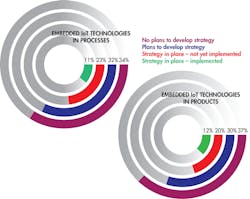This file type includes high-resolution graphics and schematics when applicable.
Numerous initiatives have been put into motion around the world to fundamentally transform manufacturing as we know it. Though the initiatives go by different names—from the Smart Manufacturing Leadership Coalition and Industrie 4.0 in the West, to Made in China 2025 and Manufacturing Innovation 3.0 in the East—they share a common pursuit: smart manufacturing.
This global push for smart manufacturing is underway for good reason. By providing greater connectivity across a manufacturing enterprise and the ability to act on production intelligence, smart manufacturing offers nearly unlimited opportunities for manufacturers to improve their operations, create new value, and respond to challenges such as the skilled-labor shortage. Rockwell Automation approaches smart manufacturing via the Connected Enterprise, which is an infrastructure for Internet of Things (IoT) connected systems.
For example, manufacturers use embedded machinery intelligence to predict equipment failures and improve productivity. By using remote-access capabilities to monitor multiple machines simultaneously from a centralized location, they can better utilize labor. They are extending this greater connectivity and information sharing outside their production walls to better track and coordinate supply-chain activities. And through the use of contemporary cloud technologies, they are able to change business models and build new revenue streams.
However, while some forward-thinking manufacturers fully embrace smart manufacturing and are already reaping the benefits, most still have much work ahead of them. Case in point: Only 11% of manufacturers have implemented a strategy to apply IoT technologies to production processes, according to a recent survey by The MPI Group. Even worse, about half of manufacturers said they are still struggling with the basics of defining and implementing an IoT strategy.
Building the Infrastructure
Adoption of key enabling technologies is an essential part of a smart-manufacturing approach. This includes leveraging the IoT, an ever-growing proliferation of connected smart devices, to better understand quality, efficiency, security, and safety. It also involves the strategic use of cloud computing, mobility, and data analytics.
And while most manufacturers are not yet prepared to deploy smart-manufacturing technologies, they clearly see opportunities for using them. According to the MPI study, the top five objectives that manufacturers identified for incorporating the IoT into their operations are improved product quality, increased speed of operations, decreased manufacturing costs, improved maintenance and uptime, and improved information for business analytics.
Achieving these objectives requires an integrated architecture and a strategy for using smart-manufacturing technologies. Specifically, manufacturers must converge their Information Technology (IT) and Operations Technology (OT) systems into a single, unified network infrastructure. In addition, they must identify opportunities for using IoT technologies that enable seamless connectivity and information sharing across people, processes, and things.
At the same time, manufacturers also need to ensure they can efficiently manage their greater abundance of data in ways that helps them make better, faster business decisions. This includes using IoT device intelligence, cloud connectivity, and data analytics all together to help manage the large data sets required for balancing production activities based on upstream inventories and downstream demand. Manufacturers seeking to build and implement IoT connected systems in support of a smart-manufacturing deployment in their operations should focus on the following four core tactics:
1. Increasing Quality and Productivity
Quality-management and continuous-improvement programs can only do so much when the information they rely on is limited or not available in real time. Manufacturers use embedded machine or equipment intelligence to monitor virtually every product specification in real time, either from a customer or regulatory perspective. More than that, they use this intelligence to rapidly address product defects and variations as they happen, ensure quality goals are met, and improve customer satisfaction.
Better control and transparency of manufacturing processes via embedded intelligence also creates new opportunities to improve productivity. For example, operators on the plant floor are now analyzing real-time production data to uncover hidden inefficiencies and more quickly implement changes. At the supply-chain level, managers and logistics professionals use smart-manufacturing technologies to deliver critical information, such as forecasts and schedules to suppliers, while also monitoring delivery performances.
2. Improving Decision-Making
Better decision-making begins with working data capital. However, most manufacturers have older systems in place that will need to be updated for the next generation of productivity. This involves reconciling their disparate OT data sources with their current IT systems, extracting the right data from smart-manufacturing technologies, and transforming that data into actionable information.
Manufacturers that have taken these steps and armed themselves with better information are using it to optimize their assets, improve their responsiveness to changing customer needs, refine work flows, and reduce inventory. More than that, they are gaining new strategic insights that help them understand their business in deeper ways, including:
• Identifying operational strengths and weaknesses
• Analyzing processes and planning improvement initiatives
• Designing and implementing better production systems
• Developing targeted training programs
• Establishing performance-management systems
3. Establishing Safe and Reliable Operations
Achieving safe, compliant, and reliable operations is an ongoing concern for any manufacturer, and smart manufacturing opens up new opportunities for dealing with some of these age-old challenges. The most obvious opportunities will include replacing the obsolete and isolated automation systems that have exceeded their lifespans, are difficult to connect, and are no longer supported by their manufacturer. However, manufacturers also should define new requirements based on past performance in areas such as employee injuries, machinery downtime, and work stoppages.
From there, they can prioritize processes and equipment for redesign. They should consider using embedded intelligence to gather real-time data, including equipment status and exception-based reporting, that can be contextualized and delivered as role-based analytics in areas like quality, safety, compliance, energy usage, and downtime issues.
Different stakeholders, from quality and safety managers to operators and maintenance technicians, can use that information to optimize machine performance, manufacturing processes, compliance, and more. Manufacturers should also make these processes collaborative, such as asking line workers about which smarter machine assets can provide more visibility and control of complex production processes.
4. Securing the Infrastructure
Greater information availability and more connection points may introduce greater risk to manufacturing environments in the form of internal and external threats. Indeed, cyber attackers are now looking beyond corporate servers to target operations technologies, while decades-old devices and controls on the plant floor can be more susceptible to breaches through both malicious attacks and unintentional employee actions.
No single security technology or methodology will suffice in this complex threat landscape. Instead, manufacturers must employ a comprehensive, defense-in-depth approach that establishes security safeguards at different layers to stop threats on multiple fronts.
A robust and secure network infrastructure should be built on standard and unmodified Ethernet, which has become the industry preference for security purposes. It also should ensure technicians can securely manage software installations, patches, and upgrades for years to come, and incorporate strong security policies and procedures for everything from machine operations to bring your own device (BYOD).
Beginning the Journey
Smart manufacturing offers nearly unlimited potential, and it all begins with establishing an IoT connected system as the foundation for achieving greater connectivity and information sharing. Some of the most common questions that manufacturers are asking today as they prepare to build an IoT system are:
What continuous improvement processes can smart manufacturing help me with?
This will depend on a manufacturer’s specific operations and business goals. But some good areas to start with include overall equipment effectiveness (OEE), product quality, downtime, scrap, worker safety, and energy consumption.
What business process transformation is going to provide me with a competitive advantage? And is smart manufacturing going to get me there?
Enterprise-wide connectivity can help manufacturers better coordinate operations across all levels to create more demand-driven operations. Asset intelligence also is able to transform maintenance approaches from reactive to predictive to help improve uptime. In addition, automated data collection and reporting can significantly save time compared to manual processes, especially in highly regulated industries.
What organizational changes are needed to facilitate smart manufacturing?
IT/OT convergence is essential, and a similar convergence must occur within the workforce. IT and operations personnel have historically worked separately from each other, but tighter collaboration will be needed moving forward. Manufacturers must bridge the gap between these two groups while equipping them with new skills for managing industrial networked technologies.
How do I measure the benefits?
The same working data capital used to monitor operations will help quantify benefits. Data can be historically viewed over set periods of time in key-performance-indicator (KPI) dashboards to measure OEE increases, quality improvements, scrap reduction, labor utilization, and more. Standardizing data collection and reporting can also help compare performance across sites.
Am I ready for an ongoing journey versus a one-time event?
Any journey into developing IoT connected systems should begin with a comprehensive assessment. With an eye on the manufacturer’s current and future states, the assessment should cover the organization’s network infrastructure, manufacturing environment, data and reporting capabilities, and security policies. In the end, this will help identify what can be upgraded and what needs replacing.
Beth Parkinson is Market Development Manager for Rockwell Automation.







